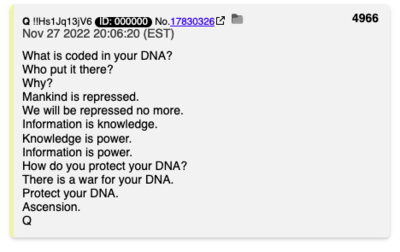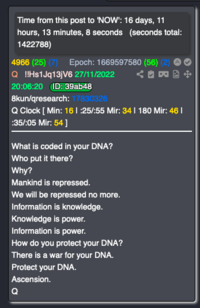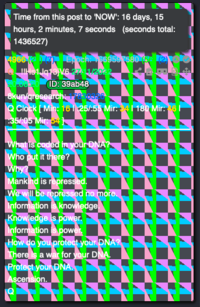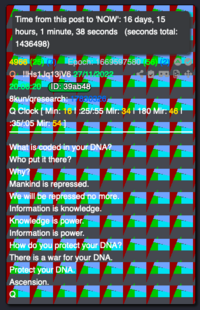Toward a Minor Tech:Wilson
QAnon, QAgg, and the Production of Scale
In QAnon, primary mechanism though which the writing of the phenomenon’s titular figure (known as ‘Q ’) is considered ‘authentic’ is by way of their posting exclusively to the image board they call home – currently 8kun.[1] While providing an adequate means for producing a sort of provenance for Q’s ambiguous missives – known as ‘Q drops’ – this practice of “no outside comms” beyond the anarchic and ephemeral 8kun produces a tension with another central aspect of the QAnon phenomenon.[2] Namely, the command to ‘do your own research’: that is, to not take the claims Q or other QAnon participants at their word, but to analyse and situate these claims for oneself – typically through the mapping of contemporary events to the content of the Q drops.
But how does one do such ‘research’? If one were to look to the image boards wherein Q dwells for such a task they would find that the Q drops are spread across three websites (4chan, 8chan, and the latter’s successor 8kun) and seven boards therein (chronologically: /pol/ on 4chan, then /CBTS/, /TheStorm/, /GreatAwakening/ on 8chan, and /QResearch/, /patriotsfight/ and /projectdcomms/ on 8kun), with local archives for these boards ranging from non-existent (4chan) to extremely patchy and unsearchable (8chan/kun).[3] Under these conditions, QAnon’s ur-text appears as a distributed and disjointed series of image board posts with unstable authorship. Q drop aggregators intervene at this point, collecting the (currently 4,399) Q drops into an online archive and presenting these and other materials as a coherent whole upon which ‘research’ can be conducted, in addition to affording their materials’ distribution across the wider web including the major corporate platforms – despite QAnon’s ostensive ‘deplatforming’ after its pandemic-facilitated ‘boom’ and the events of 6 January 2020 (O’Connor et al., 2020).
In essence, by enabling multiple distributed acts of individual ‘research’ on the part of QAnon participants, Q drop aggregators simultaneously facilitate the production of ‘QAnon’ at the immense scale that the phenomenon has achieved. QAgg.news (hereafter, ‘QAgg’) is inarguably the most complex example of such an archival infrastructure within QAnon, and it is this particular Q drop aggregator that is this essay’s focus. Here, ‘complex’ is not intended to suggest sophistication or legitimacy on the part of QAnon’s ‘researchers’ or their methods, but more akin to a kind of paranoid psychosis where the Q drops and other relevant materials are analysed in increasing levels of detail and abstraction.[4] First describing the research and distribution affordances found within its interface, this paper will then turn to the question of how these tools aid in the production and maintenance of QAnon’s immense scale.
Where the Q drop aggregators that preceded QAgg (like QAnon.pub, see fig. 1) were largely concerned with simply making the content of the Q drops available for ‘research,’ QAgg is additionally concerned with what the metadata of these materials might reveal and, therefore, orients its methodological affordances around the investigation and manipulation of its database via these elements. The visibility of this metadata is toggled by way of the site’s ‘digging options’ (fig. 2), which also afford the ability to filter or rearrange the order of the materials in the interface. In essence, the affordances of QAgg represents the methodological avant-garde of QAnon ‘research,’ wherein every thinkable mechanism for the extraction of meaning has been operationalised upon the Q drops.[5]

|

|
| Figure 1: Screenshot of Q drop 4966 (the most recent at the time of writing) as it appears on QAnon.pub (left) and QAgg (Right). | |
QAgg also offers several means through which users can share the contents of Q drops to other platforms and, therefore, facilitate the dissemination of their ‘research’ and include means to generate a direct link to a given Q drop, copy its text, or generate a jpeg image of it. The most consequential distribution tool, however, is ‘digital camo.’ This tool produces a randomly generated dazzle camouflage pattern underneath the content of a Q drop in what appears to be an effort to evade image recognition-based moderation systems and, therefore, allows for the circulation of Q drops on platforms where QAnon has been banned (Facebook, Google, Twitter, see also fig. 3). Whether or not such mechanisms of evasion work, that such an anticipation of machinic moderation exists speaks to questions of QAnon’s scale and in this sense perhaps a recognition of the salience of major social media platforms in producing it.

|

|

|
| Figure 3: Some examples of digital camo as applied to Q drop 4966. | ||
While Q themselves may be located on the chans and it was on these imageboards that ‘QAnon’ began to emerge, the true becoming QAnon was with the development of the archival infrastructures discussed in this essay. Not only did they allow for the organisation of the phenomenon at the level of its materials and ‘research’ practices therein, but they also serve as distributive vectors for QAnon’s materials. Although none of the methods QAgg facilitate necessarily appear to imperil forms of legitimate inquiry there is nevertheless the sense that the performance of ‘research’ herein is sufficiently ‘scientistic’ (Proctor, 2018) that epistemic hazards arise regardless (see also Lee et al., 2021).
Reference List
Hagen, S. (2018). Rendering legible the ephemerality of 4chan/pol/ – OILab. OILab. https://oilab.eu/rendering-legible-the-ephemerality-of-4chanpol/
Hagen, S. (2022). ‘Who is /ourguy/?’: Tracing panoramic memes to study the collectivity of 4chan/pol/. New Media & Society, 146144482210782. https://doi.org/10.1177/14614448221078274
Hoback, C. (Director). (2021, March 21). Calm Before the Storm (No. 1). In Q: Into the Storm. HBO.
Knuttila, L. (2011). User unknown: 4chan, anonymity and contingency. First Monday, 16(10). https://firstmonday.org/ojs/index.php/fm/article/view/3665
Lee, C., Yang, T., Inchoco, G., Jones, G. M., & Satyanarayan, A. (2021). Viral Visualizations: How Coronavirus Skeptics Use Orthodox Data Practices to Promote Unorthodox Science Online. Proceedings of the 2021 CHI Conference on Human Factors in Computing Systems, 1–18. https://doi.org/10.1145/3411764.3445211
O’Connor, C., Gatewood, C., McDonald, K., & Brandt, S. (2020). The Boom Before the Ban: QAnon and Facebook. Institute for Strategic Dialogue.
Proctor, D. (2018). Policing the Fluff: The Social Construction of Scientistic Selves in Otherkin Facebook Groups. Engaging Science, Technology, and Society, 4, 485–514. https://doi.org/10.17351/ests2018.252
[1] Per Q drop 465 (after the Q’s move from 4chan to 8chan due to the latter’s being ‘compromised’): “No other platforms used. No comms privately w/ anyone.” In reality, this move (platform and rhetorical) was likely an effort on the part of one of the individuals behind Q to consolidate their control over the account (see Hoback, 2021).
[2] See Knuttila (2011) Hagen (2018) for discussions of how the affordances of ‘chan’ boards produce their unique user cultures as well as to get an idea as to why such techno-cultural conditions pose a problem for the ‘research’ efforts of QAnon participants.
[3] While there are extensive and accessible external archives of these boards, such infrastructures do not really figure in the discourses of 4chan and 8chan/kun as it is occurring and could arguably not be implemented given their feverish temporality of posting (see Hagen, 2022).
[4] While this essay will be exclusively discussing QAgg’s handling of Q drops, it must be noted that it maintains extensive archives of Twitter, Gettr, and Truth Social posts from several figures and organisations that are salient within the QAnon worldview, with the ‘digging options’ outlined herein also applied to these materials.
[5] And if these options are not sufficient than a user can go to QAgg’s ‘Data Science’ tab and download JSONs or CSVs of QAgg’s archives and perform whatever further analysis upon these materials they wish.
